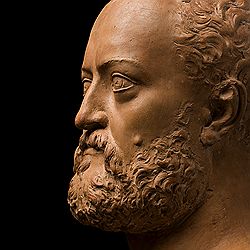The Decline of Terracotta

Under Cosimo I’s rule, there was a tendency to return to an ostentatious, imperial classical style capable of solemnly attesting to the authority of the Medici family. It came with a refined taste for precious and rare materials whereas humble materials, such as terracotta, were disregarded or, if used, imitated noble ones.
The Lives of the Artists, published in 1550 and 1568, were dedicated to the Grand Duke Cosimo I by their author Giorgio Vasari, the great historiographer who throughout his biographies of artists always considered clay a subordinate material, useful only for making models for works in nobler materials.
However, the decline of terracotta in the late 16th century is also partly linked to the controversy regarding the supremacy of one art over the others, which, reintroduced by Benedetto Varchi in 1549, would culminate in Michelangelo’s famous definition when, giving sculpture pre-eminence, he claimed : “By sculpture I mean something achieved by taking away; that which is done by adding on (plastic art) resembles painting”.
Only the advent of the 1900’s, another century prone to experimentation, restored terracotta to its lost dignity, bequeathing us original works by great artists such as Medardo Rosso, Adriano Cecioni, Libero Andreotti, and Arturo Martini.
< | >